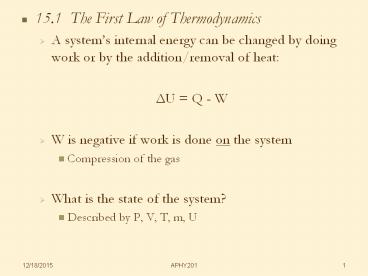15.1 The First Law of Thermodynamics - PowerPoint PPT Presentation
1 / 11
Title:
15.1 The First Law of Thermodynamics
Description:
15.1 The First Law of Thermodynamics A system s internal energy can be changed by doing work or by the addition/removal of heat: U = Q - W – PowerPoint PPT presentation
Number of Views:294
Avg rating:3.0/5.0
Title: 15.1 The First Law of Thermodynamics
1
- 15.1 The First Law of Thermodynamics
- A systems internal energy can be changed by
doing work or by the addition/removal of heat - ?U Q - W
- W is negative if work is done on the system
- Compression of the gas
- What is the state of the system?
- Described by P, V, T, m, U
2
- 15.2 Thermodynamic Processes and the First Law
- Isothermal T constant ? ?U 0 ? W Q
- Adiabatic Q 0 ? ?U -W
3
- 15.2 Thermodynamic Processes and the First Law
- If pressure is constant then
- W Fd PAd P ?V
4
- 15.2 Thermodynamic Processes and the First Law
- The total work done during a process is equal to
the area under the PV diagram
5
- 15.4 The Second Law of Thermodynamics
- Heat can flow spontaneously only from a hot
object to a cold object. - A reversible process is one that is always in
equilibrium and can return to its initial
conditions along the same path - Most natural processes are irreversible
- Sets an upper limit on efficiency of heat engines
6
- 15.5 Heat Engines
- Heat engines convert U into other useful forms of
energy mechanical, electrical, - ?Ucycle 0 ? QH W QL
- Automobile engines
7
- 15.5 Heat Engines
- The efficiency of a heat engine is
- Carnot (ideal) engine
- Reversible processes
- Too slow for real engines
8
- 15.6 Refrigerators, Air Conditioners and Heat
Pumps - A heat engine in reverse.
9
- 15.6 Refrigerators, Air Conditioners and Heat
Pumps
10
2. (a) The work done by a gas at constant
pressure is found from Eq. 15-3.
(b) The change in internal energy is calculated
from the first law of thermodynamics
11
26. Find the exhaust temperature from the
original Carnot efficiency, and then recalculate
the intake temperature for the new Carnot
efficiency, using the same exhaust temperature.

